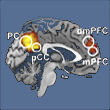Monday, 5 November 2012
Socio-Political Conflicts and Brain Imaging
 Until the start of the 21st century, brain-imaging techniques had been used chiefly to confirm the involvement of brain structures that had already been associated with well documented functions such as movement, vision, and language. But subsequently, as these non-invasive methods became more readily available, researchers began to use them to explore other, more complex functions. In this way, researchers have since discovered numerous neuronal circuits specifically associated with higher functions ranging from compassion to love, from meditation to intellectual pleasure.
Until the start of the 21st century, brain-imaging techniques had been used chiefly to confirm the involvement of brain structures that had already been associated with well documented functions such as movement, vision, and language. But subsequently, as these non-invasive methods became more readily available, researchers began to use them to explore other, more complex functions. In this way, researchers have since discovered numerous neuronal circuits specifically associated with higher functions ranging from compassion to love, from meditation to intellectual pleasure.
Recently, researchers have even demonstrated that Arabs’ and Israelis’ biases against each other were specifically correlated with activity in the precuneus (labelled PC in the image above), an area in the parietal cortex! The report on this brain-imaging experiment was published in 2010 by Emile Bruneau and Rebecca Saxe, of MIT, in Cambridge, Massachusetts. Dr. Saxe’s laboratory does research on Theory of Mind, in other words, the ability that people have to think about their thoughts, and in particular, to make hypotheses about other people’s thoughts, intentions, motivations, and beliefs.
As with other complex mental functions, when we theorize about what other people are thinking, a number of brain structures are activated preferentially: an area of the cortex at the junction of the parietal and temporal lobes, the right superior temporal sulcus, the temporal pole, the precuneus, the posterior cingulate cortex, and the medial prefrontal cortex. The exact functional contribution of each of these structures is still a matter of debate, but Saxe’s research has led her to propose that the right temporoparietal junction of the cortex plays an essential role in thinking about our thoughts.
In the study on the mutual perceptions of Arabs and Israelis, the precuneus appeared to play a decisive role. In this study, the subjects in these two ethnic groups, who share a history of conflict marked by violence and injustice, were asked to assess the “reasonableness” of statements about the Middle East that were expressed from their own viewpoint as well as from the viewpoint of the other group.
Unsurprisingly, the more favourable the statement was toward the rival ethnic group, the more the bias against it, generated by decades of conflict, was apparent in the subjects’ responses. But one finding that was fairly surprising was that the greater the disagreement that a statement elicited, the more activity was observed in a specific part of the brain: the precuneus. This special correlation was not found in other brain structures associated with general emotionally loaded situations. Thus this was the first brain-imaging study to show a specific brain activity associated with members of human groups in conflict.
![]() Saxelab: Social Cognitive Neuroscience Laboratory
Saxelab: Social Cognitive Neuroscience Laboratory
![]() Attitudes towards the outgroup are predicted by activity in the precuneus in Arabs and Israelis
Attitudes towards the outgroup are predicted by activity in the precuneus in Arabs and Israelis
![]() The right temporo-parietal junction: a specific brain region for thinking about thoughts
The right temporo-parietal junction: a specific brain region for thinking about thoughts
The Emergence of Consciousness | 1 comment








[…] [4] “The power of being heard: the benefits of ‘perspective-giving’ in the context of intergroup conflict”, en http://saxelab.mit.edu/resources/papers/2012JESP.pdf. Se encuentran varias reseñas de este artículo: https://www.blog-thebrain.org/blog/2012/11/05/socio-politiical-conflicts-and-brain-imaging-2/, […]